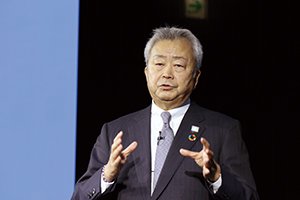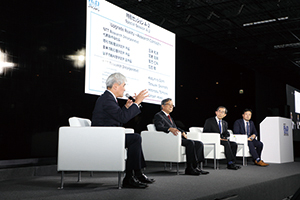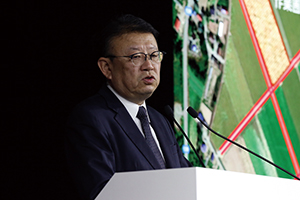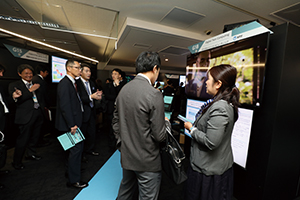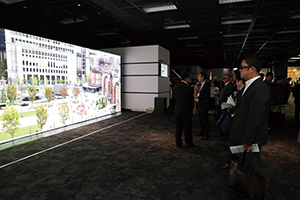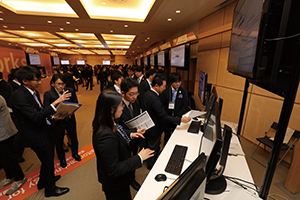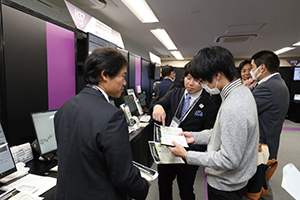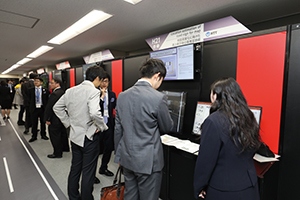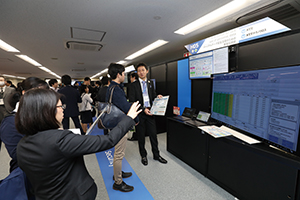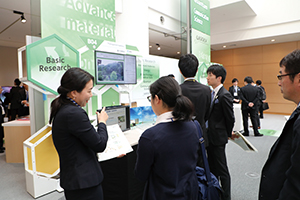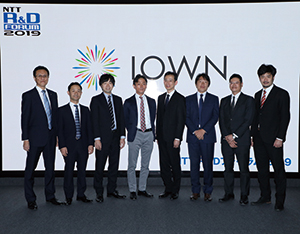 |
|||
|
|
|||
|
Information Vol. 18, No. 2, pp. 49–56, Feb. 2020. https://doi.org/10.53829/ntr202002in1 Report on NTT R&D Forum 2019AbstractNTT R&D Forum 2019 was held at the NTT Musashino Research and Development Center on November 11–15, 2019 (November 11 and 12 were set aside solely for the press and NTT Group employees). This article provides an overall of the forum. Keywords: R&D forum, IOWN, smart world 1. Forum overviewThe NTT Group is seeking to resolve social issues as Your Value Partner. In May 2019, it announced the Innovative Optical and Wireless Network (IOWN), a photonics-based concept aimed at providing a high-capacity, low-latency, and energy-efficient information communication infrastructure capable of supporting sustainable growth. NTT R&D Forum 2019 introduced the latest results of research activities carried out based on this concept through lectures and exhibits presented under the theme of “What’s IOWN? - Change the World.” 2. Lectures and workshopsOn November 13, NTT president and CEO Jun Sawada gave a keynote lecture entitled “Towards the Era of IOWN” (Photo 1). By comparing and contrasting a recycling society developed during the Edo Period in Japan with European societies during the Industrial Revolution, which was designed to encourage economic growth, he stated that NTT is seeking a society in which innovations bridge today’s social divisions arising from differences in civilization or thinking. Increasing consumption of electrical energy represents a technical constraint on sustainable development. The technical foundation of IOWN is the extremely energy-efficient photonics-electronics convergence technology that NTT is developing. Based on this technology, NTT is developing the All-Photonics Network, which will also pave the way for an ultimate future network that incorporates quantum communication and quantum encryption. As Digital Twin Computing advances, interactions within the cyberworld will become possible. When the real space works in concert with the new cyberspace, how will social institutions, the purpose of and joy in life, ethics, and responsibility manifest themselves? NTT will collaborate with Kyoto University in studying these questions, which represent a new way of looking at the world. Mr. Sawada also described Cognitive Foundation®, which automatically links various information and communication technology (ICT) resources to enable a network to evolve autonomously, and introduced NTT’s involvement in the Smart City project in Las Vegas as an example.
Looking towards the future of communication, NTT, Intel, and Sony announced the establishment of the IOWN Global Forum, an international forum that promotes photonics-related research and development (R&D) based on photonics-electronics convergence. Sixty-five companies, the majority of which are from outside Japan, are currently considering to participate in it. Mr. Sawada ended his address by inviting partners to participate in NTT projects aimed at creating a smart world. The president’s keynote lecture was followed by a presentation by Katsuhiko Kawazoe, NTT senior vice president and head of the Research and Development Planning Department, entitled “What’s IOWN? - Change the World.” The vision of IOWN is to create an innovative information processing base that will carry out vastly expanded information processing and make it possible to break through conventional technical constraints such as power consumption. IOWN consists of three elements: All-Photonics Network, which dramatically enhances the potential of the information processing base; Digital Twin Computing, which opens a new horizon for services and applications.; and Cognitive Foundation, which optimally harmonizes all ICT resources. Wireless access technology in IOWN will also penetrate everywhere, e.g., under the sea, in the air, or in outer space, resulting in a world of connected everywhere. NTT’s activities towards this goal include world-leading high-capacity wireless transmission, undersea wireless communication, and wireless transmission in outer space, with the latter being undertaken as a joint research project with Japan Aerospace Exploration Agency (JAXA). To illustrate a world made possible by IOWN, Mr. Kawazoe introduced a project involving a company, academic institution, and local government, i.e., NTT, Hokkaido University, and Iwamizawa City in Hokkaido. The aim of this project is to promote world-leading smart agriculture using cutting-edge agricultural robot technology and ICT. He concluded his presentation with a declaration that those involved in NTT R&D are committed to thinking outside the box and pursuing the welfare and prosperity of humankind propelled by a tremendous zeal for technical innovation given the urgent need to protect the global environment and ensure sustainable development. Two special sessions were held on November 14, and four on November 15. In the first session on November 14, Kazuhiro Gomi, president and CEO of NTT Research, Inc., introduced the innovation strategy of NTT Research, which is responsible for the globalization of NTT R&D, and its positioning in the IOWN initiative under the title of “Upgrade Reality - Reality in IOWN Concept.” In the second session, the directors of the three laboratories that make up NTT Research gave an overview of their respective activities. Tatsuaki Okamoto, director of Cryptography & Information Security Laboratories (CIS Labs), reported that their aim is to create a world-leading encryption laboratory and that they already have a pool of top researchers, who they hope will form a dream team in the areas of cryptography theory and blockchain. For this purpose, they will collaborate with NTT Security Platform Laboratories. Hitonobu Tomoike, director of Medical & Health Informatics Laboratories (MEI Labs), said that they are focusing on precision medicine as it enables diagnosis and healthcare to be tuned to the characteristics of each individual. For this purpose, they will apply artificial intelligence (AI), the Internet of Things (IoT), and data science in their research on health and diseases while placing the highest priority on patients. Next, Yoshihisa Yamamoto, director of Physics & Informatics Laboratories (PHI Labs), presented the challenge of fusing the principles of quantum mechanics and brain-based information processing with light. Their long-term research target is to understand how humans carry out advanced information processing, such as recognition and decision-making, as well as the nature of consciousness, by analyzing the relationships between these two principles. Lastly, a panel discussion was held with Director Okamoto of CIS Labs, Director Tomoike of MEI Labs, and Deputy Director Satoshi Kako of PHI Labs as panelists and with President Gomi acting as the moderator (Photo 2). They discussed the advantages that Silicon Valley, where NTT Research is located, offers, such as the availability of top-notch and highly motivated experts and interdisciplinary environments, and their determination to advance their research capabilities on the basis of NTT’s traditions.
On November 15, Professor Noboru Noguchi, program director of Fundamental Agriscience Research, Research Faculty of Agriculture, Hokkaido University, gave a presentation entitled “Smart Agriculture toward Society 5.0.” He spoke of a smart agriculture project that uses cutting-edge agricultural robot technology and ICT. This project is being undertaken based on an agreement involving NTT, Hokkaido University, and Iwamizawa City (Photo 3). Then, Ryutaro Kawamura, director of NTT Service Innovation Laboratory Group, gave a talk entitled “The Digital World of Humans and Society – Digital Twin Computing.” He envisioned how the acceleration of digitalization will change the world and identified key technologies that will make this change possible. This was followed by a presentation, entitled “Innovative Network Focused on 2030 (Beyond 2020),” by Arata Itoh, director of NTT Information Network Laboratory Group. He introduced the Group’s research initiatives undertaken within the context of the IOWN concept and the latest research cases. Lastly, Tetsuomi Sogawa, director of NTT Science and Core Technology Laboratory Group, presented a lecture entitled “Basic Research Supporting All-Photonics Network.” He elaborated on photonics-electronics convergence devices that make high-speed and ultra-power-efficient operation possible; innovative photonics devices that support high-capacity optical transmission; LASOLVTM, a new physical computer based on optical communication technologies; and an optical lattice clock network that serves as a next-generation frequency/time reference infrastructure.
3. Showcasing research resultsIn this forum, 106 examples of the latest research results were on display and divided into seven categories: [Special category] IOWN for Smart World; media and devices/robotics; networks; AI; data collection, management and analysis; security; and basic research. Technologies being investigated by the NTT Group and outcomes resulting from collaboration with partner companies were also presented. There were also nascent projects that went beyond the exhibition theme, such as “Action for 2020 and Beyond” and “SDG-based Assessment of ICT Solution Services.” Thus, the exhibition covered a wide range of research findings from basic research to already commercialized technologies. To enable visitors to see the results of R&D more effectively, there were not only exhibition sites devoted to specific topics but also dedicated exhibition rooms and outdoor sites depending on the nature of the topics presented. There was also a special exhibition site that introduced activities related to the special category: IOWN for Smart World (Photo 4). At these sites, visitors could view well-designed demonstrations and exhibits.
3.1 IOWN for Smart World(1) IOWN use cases Use cases of IOWN for Smart World depict a world that will be made possible by IOWN. As a use case of Digital Twin Computing, decision-making through consultation with multiple selves (digital twins) that have different abilities was demonstrated. A conceptual model of a mobility society at the time when vehicles are completely self-driven showed how people, vehicles, and roads will cooperate and interact at an advanced level. (2) Distinctive technologies for IOWN The latest R&D results for implementing IOWN were introduced and classified as Post-Moore, All-Photonics Network/Beyond 5G, Advanced Research, and Point of Atmosphere. Specifically, the following distinctive technologies for IOWN were introduced: nano-photonic acceleration and on-board/chip optical network, both based on photonics-electronics convergence information-processing technology, which makes high-performance and low-power operation possible; terabit-level transmission technology for building a high-capacity network for IOWN; and high-frequency-band analog radio-over-fiber (RoF) technology that separates signal processing from an antenna and/or radio frequency to enhance the degree of flexibility in determining wireless areas. 3.2 Media and devices/robotics(1) Media technologies that provide the novel experience of transcending time and space A theater-type exhibition presented a concept of the future in which “IOWN × Entertainment” integrates real and virtual worlds to create a transcendent experience. The following distinctive technologies were also exhibited: three-dimensional (3D) video presentation technology that allows a choice between 2D and 3D viewing (Photo 5); glasses-free 3D technology that makes 3D viewing from any angle (360°) possible; acoustic field control technology that delivers sound to only a specific area; zero-latency media technology that uses predictive expression to achieve communication that transcends time and space; and user experience (UX) technology that creates a heightened sense of reality by manipulating temperature and air.
(2) Human-machine interface technologies that expand human potential In a demonstration of technology that turns visual and auditory senses into a haptic sense, visitors were able to experience a virtual skateboard ride while sensing vibrations along with a video. Also on display were a new hands-free, stress-free, and focus-free visual sensing device; behavior-design technology that uses AI to understand a person from multiple perspectives and enables him/her to approach his/her ideal well-being; and self-transformation interaction technology that uses surrounding devices to impart how professionals use their expertise and prompts an individual to transform into someone he/she wants to be. 3.3 Networks(1) Optical and wireless technologies for an innovative network A wide range of optical and wireless technologies, each dedicated to a specific function, were introduced. They will make it possible to build an innovative network that will serve as a smart social infrastructure that can meet diverse and complex needs. They included technology that controls the network so that it can adapt to the quality requirements of individual applications and technology for underwater communication. (2) Control and orchestration technologies for flexibility and intelligence A diverse range of network control and orchestration technologies were on display. They included AI-based advanced operation technology; technology for detecting fault locations, diagnosing faults, and achieving early recovery; and technology for real-time presentation of traffic in a virtual environment (Photo 6).
(3) Use cases using network features Use cases of the following technologies were introduced: technology for low-latency transmission of a live 4K video; video-streaming architecture achieved through cooperative interactions with video-delivery providers; and network-information infrastructure technology for efficiently collecting, processing, and delivering the information needed to provide mobility as a service (MaaS). 3.4 AIThe NTT Group’s AI-related technologies, corevo®, which co-exist with people to co-create new values to enrich people’s lives, were introduced according to the following classifications. (1) AI supporting people The following AIs were introduced: technology that uses a sequence-to-sequence model to convert the voice quality and prosody of a person into those of another person of his/her choice; chat-dialogue technology for enabling conversations with unique characters; technology for identifying events from speech to achieve context-adapted dialogue; English-pronunciation training technology that uses auditory sense-based feedback; voice and acoustic emotion-processing technology that will facilitate the evolution of connected cars; technology for estimating the locations of roadside display devices for map enrichment; technology for reading non-verbally expressed emotions to improve communication quality; and an AI solution that automatically responds to visitors using audio and video. (2) AI supporting society The exhibited AIs included Smart Plant that digitizes the five human senses to improve productivity and operation rates; technology for relieving congestion during a large-scale event in real time by forecasting and guiding visitor flows; technology for automating responses to reporting of faults; angle-free object detection technology that uses image recognition to identify diverse products to reduce the need for retail assistants in shops and that becomes smarter the more it is used; and rescue-team operation-optimization technology that uses AI and urban data to shorten the time needed for ambulances to arrive at emergency scenes and transport patients to hospitals (Photo 7).
(3) AI infrastructure technologies On display were technology that produces highly accurate translation at a TOEIC®* score level of 960 (highest possible score being 990); technology that reduces the cost of creating chatbot scripts; technology that compresses space-information data to improve data-reading speed, making it easy to handle a large volume of human activity data; and pattern-recognition technology that uses sparse operation in media processing and ensures end-to-end security. 3.5 Data collection, management, and analysis(1) Innovation of system construction and operational services The following technologies were on display: technology that analyzes a code and tests it automatically and quickly focusing on the changes made in it; technology that enables rapid handling of faults by sharing expertise obtained from the analysis of the fault logs of multiple systems; and an international standard-compliant IoT data-sharing platform. (2) Real-time analysis of camera and space-sensor data Introduced were an image-recognition service lowering AI creation costs (Photo 8); a public-safety solution by exploiting incident and sensor data in public areas; and the “Hikari Deep Learning” (Carrier Cloud for Deep Learning) inference platform that carries out AI analysis of numerous video streams.
(3) Core technologies that support future connected vehicles Two technologies were on display. The first is for collecting data from numerous connected cars and simulating road environments in clouds. The second is Global Navigation Satellite System (GNSS) positioning technology that uses cloud processing to achieve centimeter-level positioning. 3.6 Security(1) Security for protecting Smart World Technologies for countering cyberattacks that are becoming increasingly sophisticated were presented. Technology for detecting fake sensor data makes it possible to protect social systems that rely on numerous sensors from attack. Secure technology for Society 5.0 detects falsification of data in OT (operational technology)/IoT devices installed throughout a supply chain. Data collection technology protects people from social engineering attacks that exploit their psychological vulnerabilities. (2) Security for creating Smart World Applications of encryption technology and technologies that create new value using cutting-edge security technology were introduced. Anonymizing technology supports the creation of highly useful anonymized information and makes secure use of personal data possible (Photo 9). A secure information-communication platform makes it possible to conduct advanced data analysis while protecting privacy and commercially sensitive information.
3.7 Basic researchBasic research projects that are revolutionizing society were presented. They included innovative information-processing technology in the Post-Moore era, advanced medical care, and advanced materials. Cutting-edge basic research projects that are aimed at the creation of new principles and concepts for the future were also presented. They included Danswing paper, which uses illusion to make it appear that printed materials are moving; a transparent battery that can be used to make devices virtually invisible (Photo 10); optical meta-surface, which conveys information of invisible light to AI; and middleware for LASOLV, which solves challenging problems at an extraordinary speed.
4. Conclusion of the forumWe were able to welcome more than 17,000 visitors, including those from abroad. We believe that this large number reflects the expectations of NTT Group employees and our customers for the first NTT R&D Forum after the announcement of the IOWN concept. Visitors to the exhibit sites and those who took the questionnaire survey or sent us inquiries after the forum clearly expressed their high expectations for NTT R&D. To live up to these high expectations, we will redouble our efforts in all areas from basic research to the development and deployment of new technologies. Trademark notesAll brand, product, and company/organization names that appear in this article are trademarks or registered trademarks of their respective owners.
Authors (from left): Norio Sakaida, manager, Research Planning Department, NTT Science and Core Technology Laboratory Group; Tomota Ieyasu, manager, R&D Planning, NTT Research and Development Planning Department; Hideo Kato, manager, R&D Planning, NTT Research and Development Planning Department; Takayoshi Mochizuki, manager, R&D Planning, NTT Research and Development Planning Department; Tomohisa Hosoda, senior manager, R&D Planning, NTT Research and Development Planning Department; Yasushi Matsuno, manager, R&D Planning, NTT Research and Development Planning Department; Kentaro Hotta, manager, Planning Department, NTT Information Network Laboratory Group; Masaki Hisada, manager, R&D Management, Planning Department, NTT Service Innovation Laboratory Group |
|||

